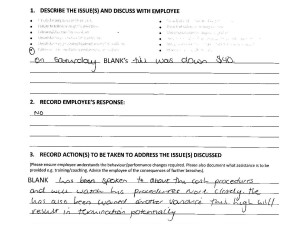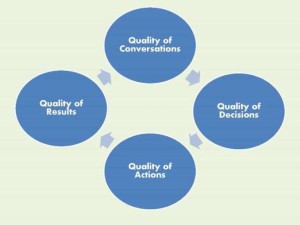In 2004, Peter Drucker, an Austrian-born American management consultant, educator, and author, published What Makes an Effective Executive in the Harvard Business Review.
Drucker outlined eight practices and one rule that he had identified from the most effective executives with whom he had worked and/or studied. Let’s look at each of them and see if they are still useful.
 1. Ask, “What needs to be done?“.
1. Ask, “What needs to be done?“.
This question provides focus. Nothing is more relevant. Focus implies prioritising. What do you prioritise? The activities that are going to give you the biggest returns/outputs for your efforts in the context of achieving the long-term success you are striving to achieve.
This question is also specific for the leader. “What tasks are aligned to my talents?” These are the tasks the leader ought to focus on, and delegate the rest of the tasks to others for whom the tasks match their exceptional talents.
Is this practice still useful?
Yes. This practice is certainly useful. Anything that provides focus in this age is useful. Distractions cost time and time costs money. Whether you are a for profit, not for profit, government or military organisation, time cannot be wasted with the limited resources that are available.
2. Ask, “What is right for the enterprise?“
This question has a long-term focus and causes the leader to consider their responsibilities as a steward for the organisation. “Will the organisation be better off, or at least not worse off, as a result of the actions we are about to take?”. While no leader is infallible and there are no guarantees in business, not asking this question is likely to lead to failure.
Is this practice still useful?
Yes. Today’s actions must always be taken in the context of the longer term and the greater good of the organisation.
3. Develop action plans
Drucker explains that plans are a statement of intention. They ought to be living documents that change as forces require them to change. They should not become ‘straightjackets’ that stifle opportunities. Regularly checking progress data, learning from mistakes and successes should all provide information that is used to update the plan.
Is this practice useful?
Yes. Plans provide the detail for our focussed actions.
4. Take responsibility for decisions
Drucker says, “A decision has not been made until people know:
- the name of the person accountable for carrying it out;
- the names of the people who will be affected by the decision and therefore have to know about, understand, and approve it—or at least not be strongly opposed to it—and
- the names of the people who have to be informed of the decision, even if they are not directly affected by it.”
Critically, Drucker advises that a ‘decision review system‘ must exist where decisions are evaluated against results. How many of your decisions would pass this test? Not many, I dare guess.
Is this practice useful?
Yes. Even though few people can claim to follow this rule, it doesn’t mean that it isn’t useful. The recent events with CommInsure highlight that leaders need to continually communicate their decisions, their reasons for them, who they will affect and be open to opposing voices from within the organisation who challenge the thinking behind the decisions. Groupthink is dangerous for organisations. Just ask Enron, BP, Arthur Anderson, the Hastie Group, and more recently Dick Smith (although we are yet to know the full underlying reason behind the collapse of this company) etc. about the quality of their decision-making processes.
5. Take responsibility for communicating
Effective communication is one of the greatest leadership challenges of the 21st century. Do your staff know what they need to know, when they need to know it? As a leader, do you know what you need to know, when you need to know it.
Michael Marquardt, author of Leading With Questions believes that effective leaders regularly ask the following three questions of as many staff as possible:
- What are we doing well?
- What aren’t we doing well?
- What would you do if you had the power and authority to create positive change in this organisation?
Is this practice useful?
Yes. It always will be. A tip to help you to increase the likelihood that your team members will know what they need to know when they need to know it, is to make sure that important information from you to them is conveyed by at least three channels of communication e.g. verbally in a meeting, written via an email, published as an article on your company’s intranet.
6. Focus on opportunities, not problems
Jack Welch, while CEO of GE, was famous for teaching his leaders that they must become adept at seeing reality for what is really was, not what they might have wanted it to be. And then, to seek out the opportunities.
As Drucker highlighted, problems need to be solved, but they don’t produce results. Acting on opportunities does.
Is this practice useful?
Yes. Particularly the ability to assess reality for what it is. This leadership skill cannot be underestimated because it allows opportunities to be identified and seized with perfect timing.
7. Run effective meetings
Aah meetings. How many of you think most of the ones you attend are a waste of time? The problem is that too many meetings really are a waste of time.
Drucker advised that you should consider what type of meeting you are going to conduct, well in advance of the meeting. His reasoning was that different types of meetings require different forms of meetings which are driven by the different results they are seeking. His logic makes sense.
Is this practice useful?
Absolutely. At least half of a leader’s time is spent with other people. If this time with other people is not a meeting, then what is it? In this context, making use of this time is critical if a leader is to be effective. Drucker’s suggestions for the different types of meetings to achieve different results is well worth the read – and his suggestions are as relevant today as they have ever been.
8. Think and say, “We”
Leadership is not about you. It is about your organisation and those whom you are serving. They come first.
Is this practice useful?
Yes. As a practitioner of Servant Leadership it is possibly the most important of all Drucker’s practices.
Drucker’s rule – Listen first, speak last
In order to practice this rule a leader must be genuinely curious. Refer to practice 5 above for the three questions that a leader can regularly ask their staff.
Is this rule useful?
Yes. 100%. Use it. Follow it. Practice it. Your leadership needs this rule.
16 years may have passed since Drucker published his article. Each one of his eight practices and his single rule are as important today as they have ever been. They are interdependent and feed off each other. One thing is certain, they won’t harm your leadership effectiveness if you show them. In fact, the opposite will be true.
Gary Ryan helps talented professionals, their teams and organisations to move Beyond Being Good®.










